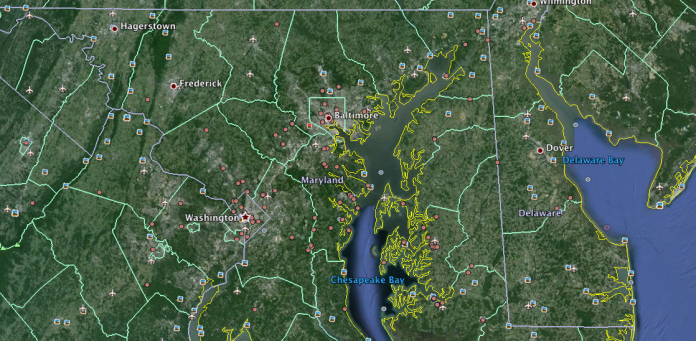SALEM, Ohio — Some farmers within the six-state Chesapeake Bay Watershed say they want to retain local control over the nutrient loading issue that has caused severe environmental consequences to North America’s largest estuary.
The American Farm Bureau Federation announced Oct. 8 that it will appeal a federal district court’s decision to uphold a stringent set of rules by the U.S. EPA that would determine the total amount of nutrients that can enter the estuary and set new land use restrictions within the 64,000 square-mile watershed.
The EPA’s rule, known as the Chesapeake Bay Total Maximum Daily Load, or simply “pollution diet,” was formed over the past decade and broadly seeks to reduce the amount of nitrogen, phosphorus and sediment entering the Chesapeake Bay, while imposing new restrictions on crop and animal agriculture, as well as municipalities.
The Middle District Court of Pennsylvania upheld the EPA’s TMDL in a Sept. 13 decision. The American Farm Bureau and Pennsylvania Farm Bureau announced this month they are appealing, saying the current decision gives federal government “wide latitude” to dictate local land use decisions.
“This is a wrongly decided case that has dangerous implications for farmers and many others in the Chesapeake Bay area and nationwide,” said AFBF President Bob Stallman, in a released statement.
Stallman said the appeal is not over whether to protect the bay.
“We all share that goal,” he said. “This case is about whether EPA can dictate where farming will be allowed, where homes can be built, and where businesses can be established.”
Other parties
The National Corn Growers Association is also appealing.
“Our organization understands and supports the need to protect water quality but we don’t support a wrongfully decided case when it has a profoundly negative impact on agricultural production and innovation,” said NCGA President Martin Barbre.
By comparison
The EPA says more than 40,000 Total Maximum Daily Load limits have been approved across the nation, but this one is the largest and most complex.
It limits nitrogen in the bay to 85.9 million pounds, phosphorus to 12.5 million pounds, and sediment to 6.45 billion pounds, per year.
Comparatively, that means a 25 percent reduction in nitrogen, 24 percent reduction in phosphorus and 20 percent reduction in sediment.
These limits are also divided by jurisdiction, and by major river basins.
The many pollution controls in the TMDL are to be in place by 2025, with practices in place by 2017 to meet 60 percent of the necessary pollution reduction.
State governments and farmers within the watershed have been pursuing conservation measures for many years, including adopting new Best Management Practices.
But over time, federal oversight has increased. In May of 2009, President Barack Obama signed an executive order which directed the federal government to lead a “renewed effort” to restore the watershed.
Farmer reaction
Marty Yahner, a grain and beef farmer from Cambria County, said the federal takeover has not been for the better. His family farms about 2,200 acres of diversified crops and finishes about 500 head of beef steers.
“The EPA’s modeling is flawed and was flawed and continues to be flawed,” he said. “They’re not giving credit to farmers.”
Yahner, who also serves on the Pennsylvania Farm Bureau board of directors, said farmers in his state are already pursuing conservation measures that work, along with cooperation from state agencies like the Pennsylvania Department of Environmental Protection.
He said the fishing and crab industry are improving, and that the work being done is making a difference.
“They (U.S. EPA) don’t as an agency recognize that farmers are implementing these,” he said. “There are many, many best management practices (in use) because it’s the right thing to do.”
He and the Pennsylvania Farm Bureau are also concerned about provisions within the rule that some say could require farmers to take as much as 20 percent of the watershed’s cropland out of production, and plant it to trees and grasses.
The appeal argues that the federal government has overstepped its power under the Clean Water Act, which Farm Bureau says was intended to empower states to carry out clean water measures.
“Congress did not intend to grant EPA limitless power to dictate how private land can be used under the Clean Water Act,” said Pennsylvania Farm Bureau President Carl T. Shaffer. “In fact, Congress specifically reserved land use decisions for state and local authorities, not EPA.”











I am always amused at the many sections of Farm Bureau that state they are concerned about the pollution they create and yet will not plant barriers to stop the pollution. If they were so concerned they would limit the number of CAFOS in the watersheds but that does not seem to be on their agenda. Ohio is promoting more CAFOS in the Lake Erie watershed which creates the algae for Lake Erie. CAFOS create the pollution, but rather than eliminating them, and returning to the traditional method of animal industry they are expanding them, at least in Ohio. Industrial livestock operations destroyed my property and life and I will continue to speak out until Farm Bureau addresses this issue in a productive manner instead of sweeping it under the rug.
just checking in to see if fracking is in ottawa county yet marblehead and danbury twp?
Hi Sonja,
Though your comment is unrelated to the article on which you left it, I can answer your question about hydraulic fracturing in Ottawa county.
Few of the Utica shale maps currently available have the Utica extending that far west. That’s not to say there won’t ever be drilling there, but for the time being, it looks unlikely.